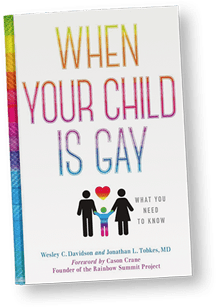In the book When Your Child Is Gay: What You Need To Know, co-author Jonathan L. Tobkes, M.D., writes that “in my practice, I have noticed that parents feel better when they realize that they are not alone and that there are people like them who are experiencing similar thoughts, feelings, and reactions to having a gay child. There are support groups in the community that you should explore. I would suggest contacting your local PFLAG organization and attending a meeting.”
PFLAG is the first and largest organization for LGBTQ + people, their parents and families, and allies. With the COVID pandemic, meetings are now done by Zoom. Many chapter meetings disband for the summer anyway.
Although PFLAG, a grassroots organization, has over 400 chapters near major cities, you can’t always find a meeting for embracing all gender identity and sexual orientation. I remember interviewing a Ft. Smith, Arkansas gay adolescent who had no access to a meeting. If that is the case, a parent can start their own meetings if they comply with PFLAG headquarter’s rules:
- You will need 3 or more individuals working together to further PFLAG goals of support, education, and advocacy.
- All chapters are required to complete chapter affiliation in order to start a PFLAG chapter. Upon completion, your chapter will gain additional benefit of non-profit status which includes ability to accept tax-deductible donations.
- You will receive discount registration costs for PFLAG National Convention, organizational materials include use of the PFLAG logo, specific talking points, tool kits and resources.
- A PFLAG National Field manager can assist you in getting your chapter started. See https://pflag.org/start-chapter.
The summer would be a good time to organize your chapter. Although meetings can vary from chapter to chapter, this format is typical:
- Find a church or community center for your monthly meetings. This is better than a private home. You may want evening or weekend meetings for working parents.
- Choose an easily accessible location, preferably near public transportation, especially near a building where an LGBTQ youth group is meeting.
- Set chairs in a circle for informality and inclusion.
- You usually start off with introductions about who they are, if they have a LGBTQ loved one and if you are straight or LGBTQ.
- Anything revealed in the room stays there. You will be sharing personal stories so it’s strictly confidential like AA meetings, etc.
- Announcements about events, LGBTQ issues, important cases are often mentioned after the mission statement.
- Sometimes, there are refreshments and cookies or raw vegetables, for example.
- Have a greeter and sign-up sheet at the door. Try to get email addresses and phone numbers so you can follow up.
- Think of ways you can make the attendee feel supported such as having a buddy system whereby you assign a mentor to the newcomer.
- Always publicize your meeting in advance. As your meetings are established, you may want to invite speakers such as authors of LGBTQ books, camp counselors for LGBTQ+ youth camps, PFLAG interns.
- You will need extra training to become a liaison to a school or delegate to PFLAG’s national yearly convention.
Some don’ts:
- Don’t allow cell phones to be on! Pictures, recordings are not allowed because of privacy.
- Do not start a meeting without a facilitator!
It’s a shame not to have a meeting near your rural town so see if you can start one! The support you receive for understanding your LGBTQ+ family member and the community-at-large is well worth it!

When Your Child Is Gay: What You Need To Know
For more detailed advice, see book, co-authored with a mother of a gay son and a psychiatrist, Jonathan L. Tobkes, M.D.